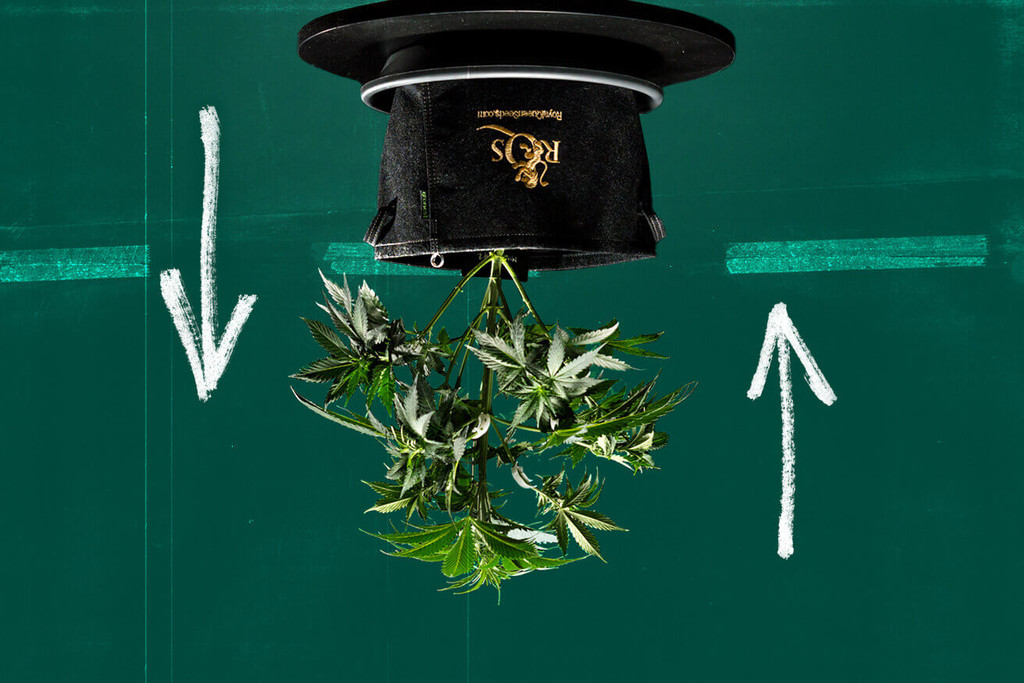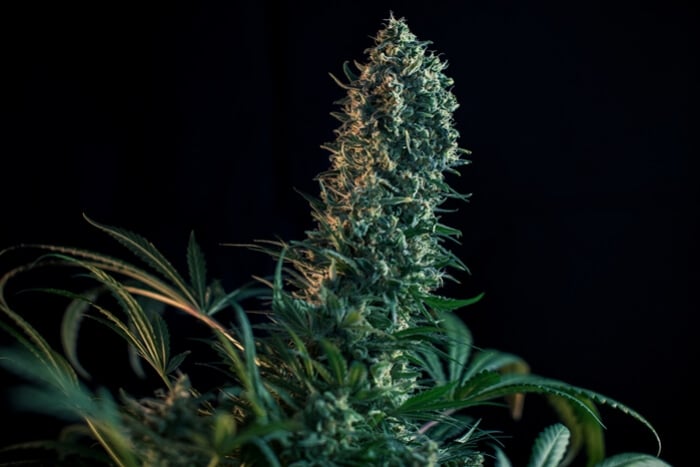.

Can You Grow Cannabis Upside Down (Topsy-Turvy Cultivation)?
Growers can employ countless different techniques to manage and shape their plants to their pleasing. Among them, growing weed upside down using the topsy-turvy method ranks as one of the most novel. But are there any benefits to this technique, or does it do more harm than good? Learn everything you need to know about upside-down weed cultivation.
Contents:
Cannabis growers are constantly seeking new and innovative ways to grow weed. Countless training methods, feeding strategies, and inputs give growers a host of different options when looking to refine their approach to growing.However, hidden among these common strategies, several unusual and less-utilised methods also exist, such as growing plants upside down. Otherwise known as topsy-turvy planting, this technique forces plants to grow out of the bottom of a suspended container.
Gardeners typically use upside-down planting for vining crops such as tomatoes, but cannabis growers are increasingly experimenting with this approach. So, is growing weed upside down an effective way to achieve healthy plants and good yields, or is it nothing more than an eye-catching gimmick? Learn everything you need to know about the topsy-turvy growing system below.
What Is the Topsy-Turvy Growing System?


The topsy-turvy growing system essentially inverts the standard way of growing weed. Normally, plants are sown into the tops of containers that are placed on the ground. In contrast, topsy-turvy plants grow out of the bottom of a pot suspended in the air or hung on a wall or trellis. Some growers create their own makeshift topsy-turvy containers, whereas others use patented upside-down planters designed chiefly to grow tomato plants.
In vegetable gardens, greenhouses, and polytunnels, upside-down planting saves floor space. This approach allows growers to place non-climbing plants, such as leafy greens, bush beans, or beetroots, on the ground while occupying the free vertical space with vining plants that hang from upside-down planters.
As all cannabis growers know, their favourite herb doesn’t adhere to a vining growth pattern. Instead, marijuana develops into an upright, bushy plant that can stand without the aid of a trellis. So, can you incorporate cannabis into a topsy-turvy growing system?
Can You Grow Cannabis Upside Down?
Yes, growers can use the topsy-turvy system when cultivating cannabis. However, the results may vary. Some species of fruits, vegetables, and herbs are much more compatible with upside-down planting than others. Squash, tomatoes, beans, and peas all thrive in this system, as they naturally vine out, meaning they’ll happily hang from an inverted plant with no negative impact on plant health and yield.
As a non-vining plant, cannabis certainly prefers growing upwards.
However, plants will still survive, and in some instances thrive, when growing in inverted planters. Unlike tomatoes and other vines, cannabis canopies won’t passively hang from a topsy-turvy planter and grow downwards. Instead, the leaves and branches will clear the bottom of the container and start growing up towards the light source. The main stem and branches will bend themselves around the container, creating a similar effect to simply growing weed in a hanging basket.
However, there is an exception to this growing pattern. Placing the light source on the ground indoors will manipulate plants to grow directly downwards from a suspended upside-down planter. But this setup defeats the purpose of saving ground space.
Pros of Growing Cannabis Upside Down
So, what benefits can you expect to reap when hanging weed plants upside down? Check out the main advantages of this method below:
- Novelty factor: Above all else, growing weed upside down just looks weird. To some growers, this adds some serious novel value to the growing space. Here, upside-down weed plants make for an eye-catching spectacle when showing friends around the grow room or garden. Growing inverted weed also provides an interesting experiment for those who are getting bored with their usual approach to cultivation.
- Space saving: Whether you’re growing in a tent, greenhouse, balcony, or outdoors in a garden, growing weed plants upside down can help to save ground space. Growers can use this additional space to grow other types of plants or even other weed plants. Plus, inverted growing might be the only viable choice in tight balconies filled with chairs, tables, and other pieces of furniture.
- Potential increases in yield: Some growers claim that growing weed plants upside down results in superior yields, touting the benefits of better aeration and improved light exposure to bud sites.
Cons of Growing Cannabis Upside Down
While novel and interesting, growing weed upside down also comes with drawbacks. Discover the disadvantages of this unusual growing technique below:
- Decreased plant health: Many growers report various plant health issues when attempting to grow weed upside down. For example, increased stress can weaken plants and predispose them to pathogen infection and pest infestation.
- Compromised root growth: The roots of flowering plants exhibit gravitropism[1]—they grow according to their sense of gravity. Obviously, roots typically grow beneath the aerial parts of the plant, down and laterally into the soil. Growing in upside-down containers means roots need to grow upwards into the pot. Gravitropism can cause issues here, stopping root systems from forming properly, which impacts plant health and performance.
- Mess: Growing in a hanging container high in the air comes with inevitable mess. Splashing water and eroding soil can make a mess of floors and plants positioned directly below.
- Potential decrease in yield: Impacted root growth and decreased plant health have the potential to reduce overall yield. Stressing plants during early veg can also compromise their growth, reducing the amount of nascent bud sites that form.
How to Grow Cannabis With the Topsy-Turvy System
Now you’re aware of the pros and cons of the topsy-turvy system when it comes to growing weed. If you’re still interested in this novel technique, continue reading to learn how to pull it off.


Equipment
- 5-gallon (19l) bucket with lid and handle
- High-quality potting soil
- Cannabis seeds
- Drill
- 5cm drill hole saw
Directions
- Place your bucket on the ground and drill several drainage holes into the lid. Remove the lid and fill the bucket with soil up to the rim. Secure the lid back in place.
- Flip your bucket over and use your 5cm drill hole saw to make a hole directly in the centre of the base.
- Soak your cannabis seed in water for 12 hours before sowing it directly into the 5cm hole.
- Keep your bucket upright until your plant reaches a height of 10cm and develops several sets of true leaves.
- Prepare to hang your bucket. Slowly turn the bucket upside down, taking care not to drop it and crush your plant. Use the handle of your bucket to hang it from a firm bracket in your grow room, greenhouse, or garden.
- Remove the lid from the top of the bucket to water and feed your plant as necessary. Consider topping your plant to send several main stems around the base of the bucket to grow upwards and achieve a more even canopy.
- Care for your cannabis plant as normal, watering and feeding as you would during a standard growing cycle.
Topsy-Turvy Weed: A Novel Approach to Cannabis Cultivation
There you have it—you now have a completely novel way to grow cannabis in your cultivation arsenal. You shouldn’t expect record-breaking yields when growing weed upside down. However, this method makes for a fun experiment, as well as a point of interest when giving your friends a tour of your growing space.
- Gravity Signaling in Flowering Plant Roots - PMC https://www.ncbi.nlm.nih.gov
Categories
Grow Cannabis With RQS































.jpg)







